
Do you struggle to get your tomatoes off to a good start? Are you tired of tall, skinny tomato seedlings each year? Does every spring storm have you holding your breath, hoping it won’t knock over your gangly tomatoes? Do you lose several weeks waiting for them to catch up once they’re in the ground?
Let’s make this the year you put all those problems behind you.
I’m going to show you how I grow robust tomato seedlings that hit the ground growing. From sowing seeds to transplanting, I’ll walk you through the whole process. Once that final frost occurs, you’ll have tomato plants that rival anything at your local garden center.
It All Starts When You Sow Your Tomato Seeds
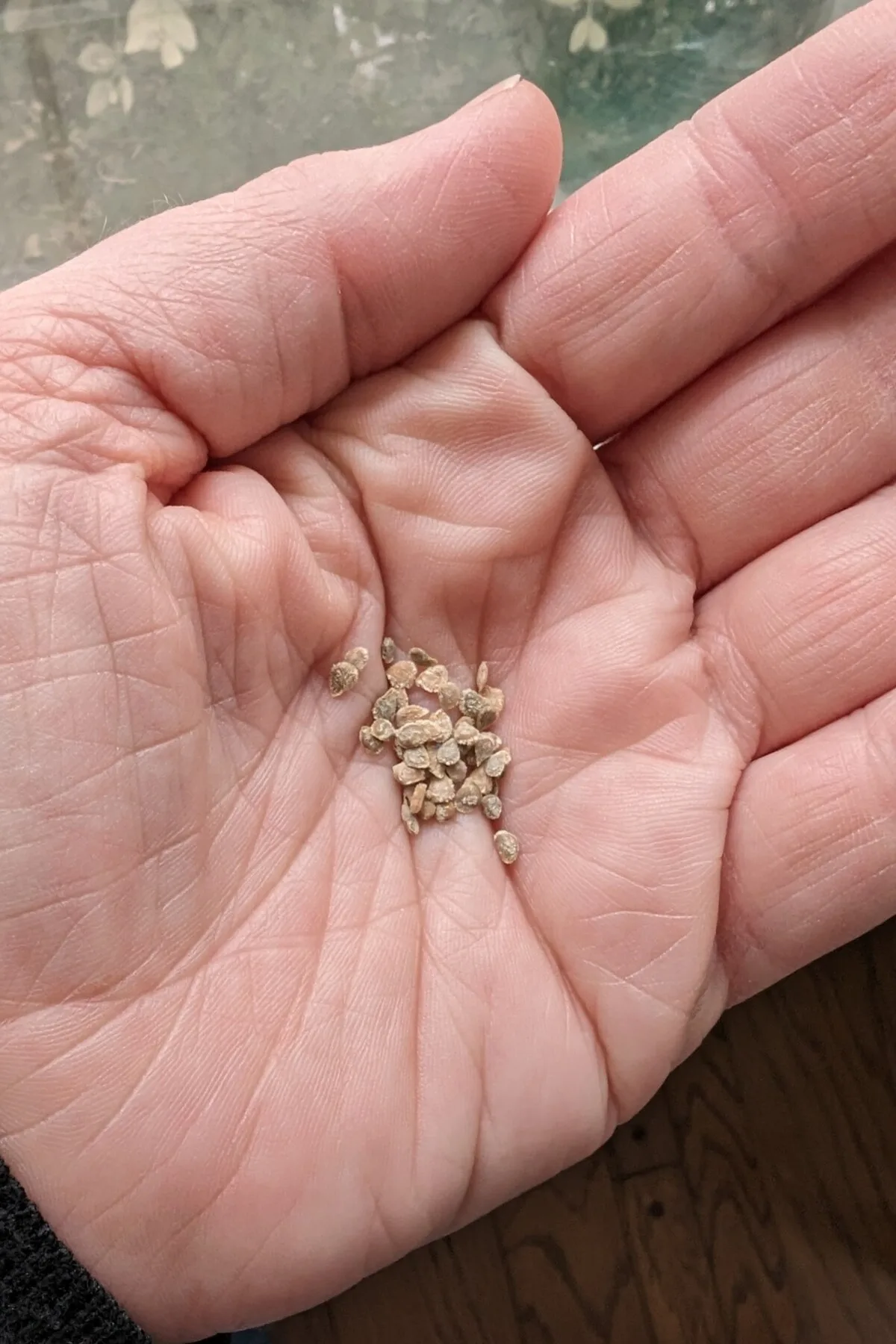
Why do we want to grow stocky seedlings? After all, given enough time, those spindly tomatoes will catch up, and eventually, they will produce fruit.
Because, as gardeners, we want to be up to our eyeballs in the tastiest tomatoes imaginable as soon as possible.
There’s only so much time in the growing season, especially if you live in a short-season growing zone. To make the most of your time and get a hefty yield of tomatoes, it all starts at the beginning.
Strong seedlings acclimate faster, suffer less transplant shock, develop larger root systems, and are less susceptible to drought, disease, and pests.
This means you get tomatoes sooner and more of them.
In essence, if you want a big tomato harvest, it all starts the moment you put that seed in a pot.
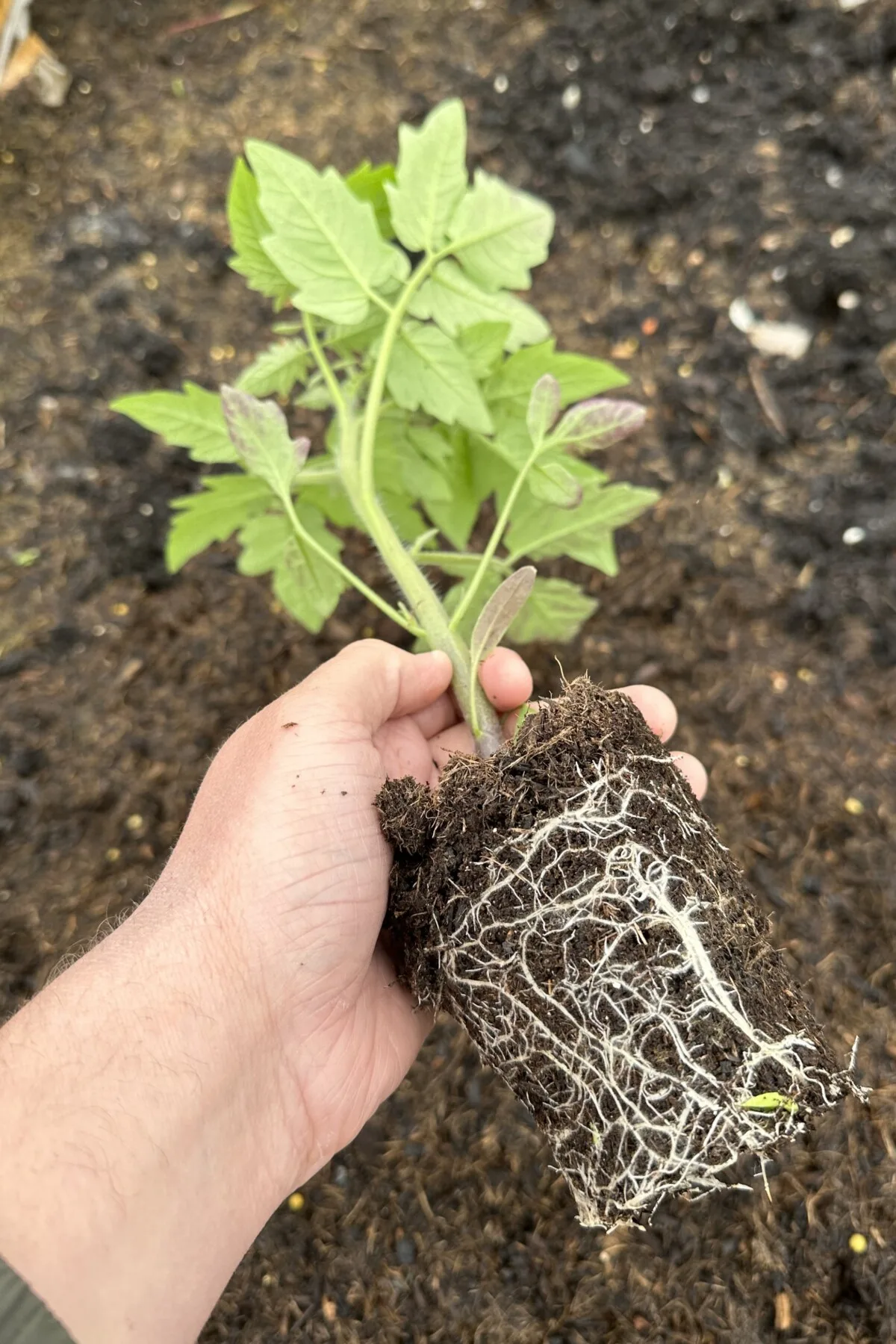
Get Started Yesterday
Whenever my sweetie asks me, “When should we get the tomatoes started?” my answer is always, “Yesterday.” As long as you have the room, tomatoes are one of the few plants where it’s a good idea to start them earlier than what’s suggested on the seed packet.
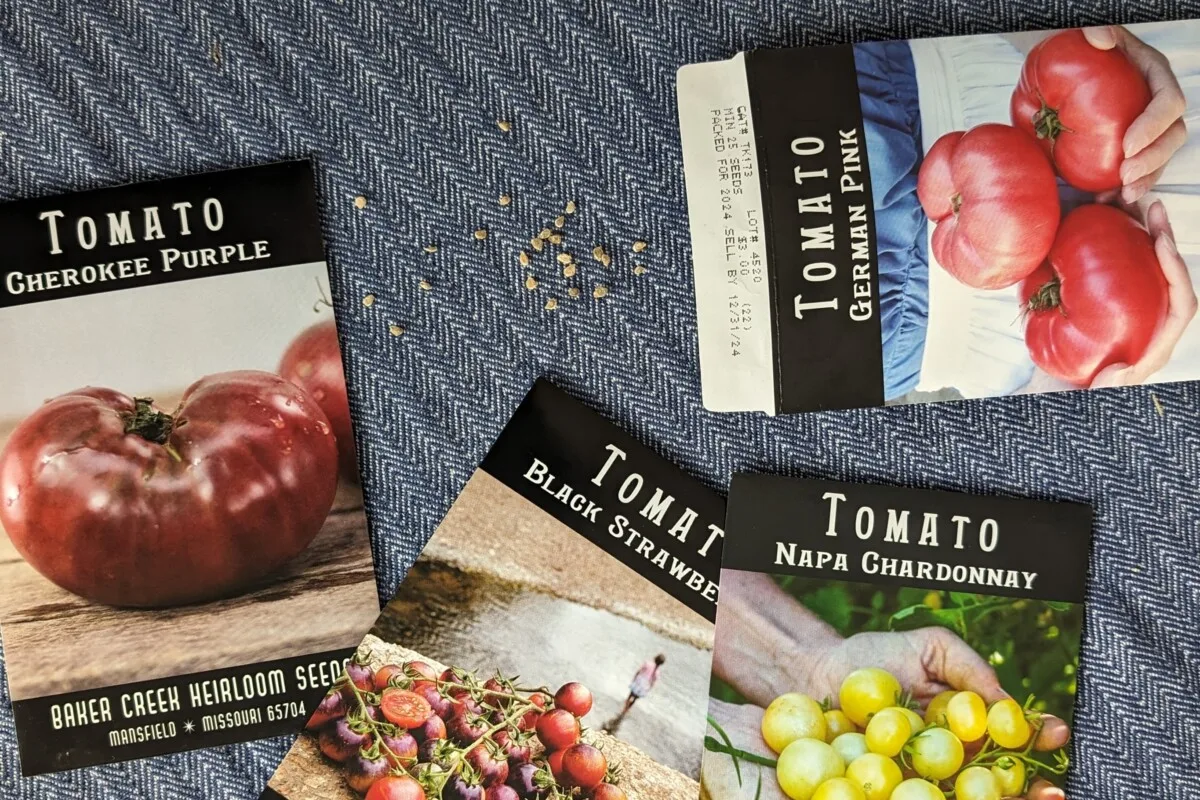
The more time they have to grow in a controlled environment, the hardier they will be when it’s time to put them in the ground.
Most seed packets suggest 6-10 weeks. We start our tomatoes around twelve weeks before the last frost date. Not only does this ensure we have big, happy seedlings when it’s time to plant, but more importantly, it gives us wiggle room to try again if things go south with germination or if we have damping-off issues.
Tomatoes Don’t Like Cold Feet – Successful Germination
Yes, you can germinate tomato seeds in unheated soil, but it can take weeks or up to a month to do so. The longer your tomato seeds sit in cold soil, the more likely the seed will rot or you’ll struggle with damping-off.
Tomatoes germinate (and grow) best in soil that’s 65-80 degrees F. At this temperature, they will germinate in a matter of days instead of weeks.
Depending on where you live, you could be starting tomatoes right smack in the coldest part of winter (Hi, friend!), so even if your home is toasty, it can be hard to keep damp soil toasty. That’s why I always use a heated seedling mat. (This one, actually. I have three of them, and I swear by them.) The mats don’t cost an arm and a leg, but they’re worth their weight in gold if you want to start seedlings indoors and you live in a cold climate.
(If you like show-and-tell, you can see my entire seed starting setup here. It’s pretty sweet.)
They keep your potting media at a specific temperature, making it easy to optimize soil temps for whatever you’re germinating.
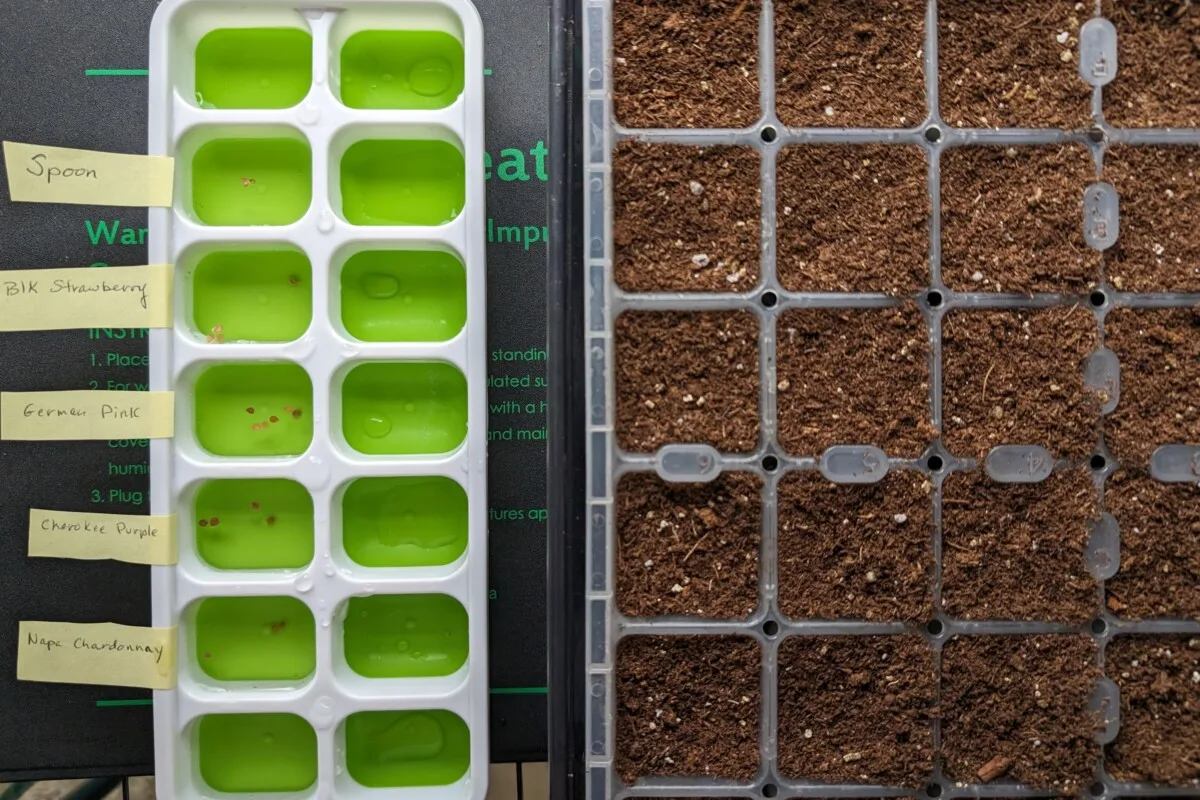
I like to prep my seed starting mix and put it in pots, then set them on the heated mats for 24 hours before I sow my tomato seeds. This gives me a chance to do two things: it allows the potting media to warm up and gives me 24 hours to soak my seeds.
By the way, ice cube trays are perfect for soaking lots of seeds at once.
You don’t have to soak tomato seeds to get them to germinate. But I find they germinate faster, and I have better success rates if I soak them first. However, it’s important not to let them soak longer than 24 hours.
Gently press your seeds into the soil, then cover them with the appropriate amount of potting mix to bury them at the correct depth. Use a fine-mist spray bottle to moisten the top layer of soil. Now, cover your seeds until they germinate. Once they start popping up out of the soil, provide ventilation and good airflow. You don’t want too much moisture.
Heirloom Tomatoes & Catfacing
If you’re a fan of growing heirloom tomatoes (Hi, friend!), then you’ve probably had your fair share of catfaced tomatoes show up in your garden.
These are the wonky tomatoes that end up with weird scarring or holes in them. This is more common in heirloom varieties than in hybrids.
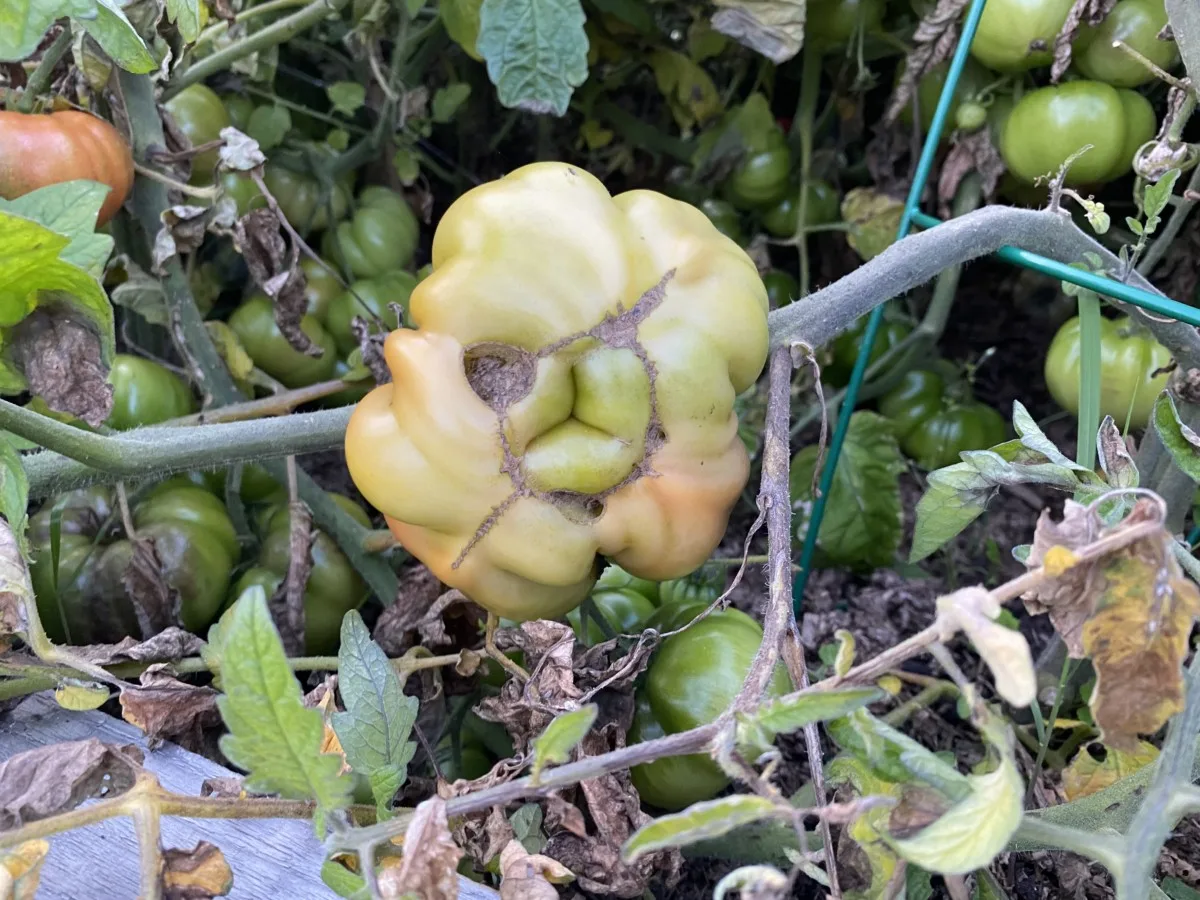
Related Reading: Tomato Catfacing – The Ugly Truth About This Bizarre Tomato Problem
Studies suggest that this issue stems from tomatoes started in temps that are too cool in the evenings (50-55 degrees F). Now is your chance to prevent catfaced tomatoes in your crop by starting them indoors, where you can keep them nice and toasty.
More Light. More Than That. A Bit More.
The biggest contributing factor to leggy seedlings is a lack of light. As humans, we are terrible at judging how much light is enough for a plant.
I’m going to level with you.
If you want to grow thick-stemmed, sturdy seedlings, your window is not enough. You’re going to need grow lights.
Yes, even if you have a southern-facing window.
Notice the difference when you walk outdoors after being in your home. It’s noticeably brighter, by a lot, even on the cloudiest of days. This is the kind of light your tomato seedlings need all day, every day, not just whenever the sun happens to be facing the window you plan to grow them in.
When it comes to healthy plants, it all starts with light.
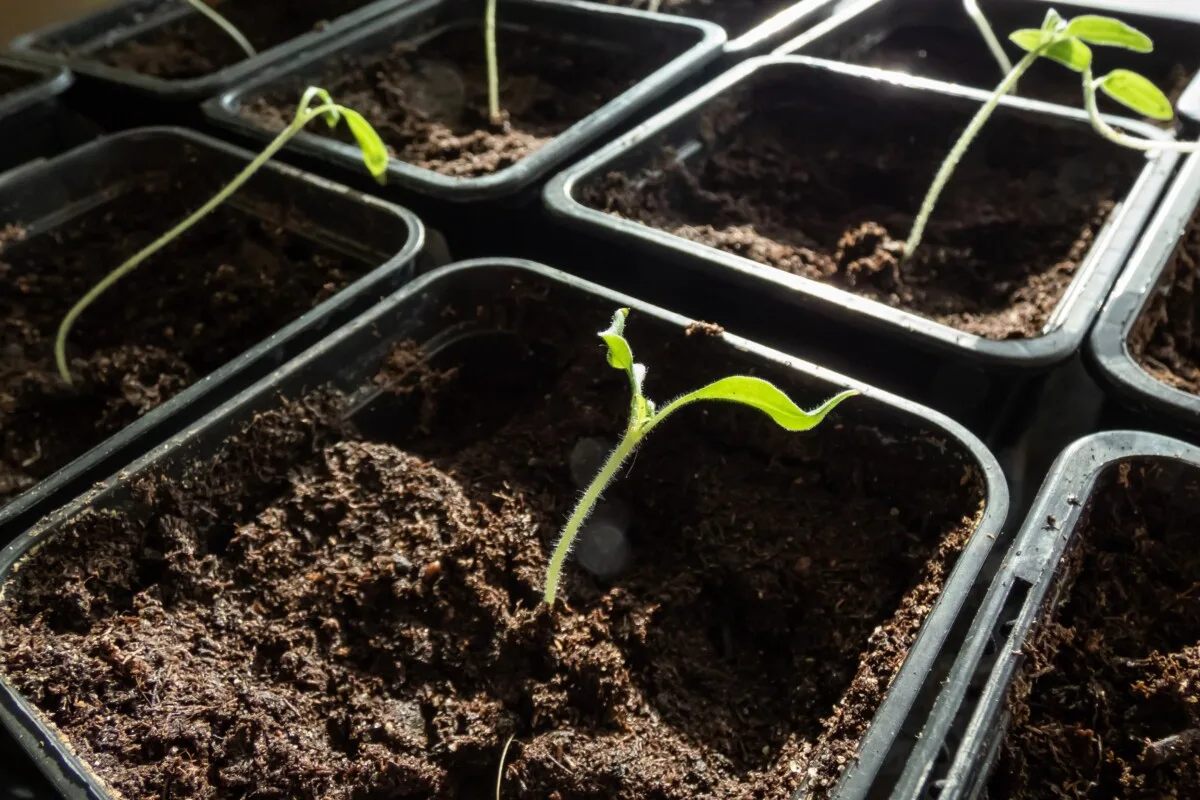
Seedlings will reach toward any light source to capture the light needed for photosynthesis. This is why you have stretched-out, leaning seedlings when you grow them in a window. To achieve stocky seedlings, they need a constant, bright light source.
Luckily, LED grow lights are affordable and efficient these days.
Tomatoes are day-neutral plants, but when starting them as seedlings, I make sure they receive twelve hours of direct light every day from these grow lights. (I spent years buying crappy lights and finally stumbled across these. I love them, and so do my plants.)
Choose quality grow full-spectrum lights. Also, keep in mind you need to provide enough light for the surface area you’re covering. Seedlings need a minimum of 2,000-3,000 lumens per square foot of surface area to prevent them from stretching.
Tomato Seedlings Need A Balance of Air and Water
Outside, plants naturally grow thick stems because they’re being buffeted by breezes. This action encourages secondary growth in plants, which is what thickens the stems and branches. To simulate this indoors, I have my sweetie stand next to the seedlings and blow on them for a couple of hours each day. Just kidding. A small fan set to low does the trick.
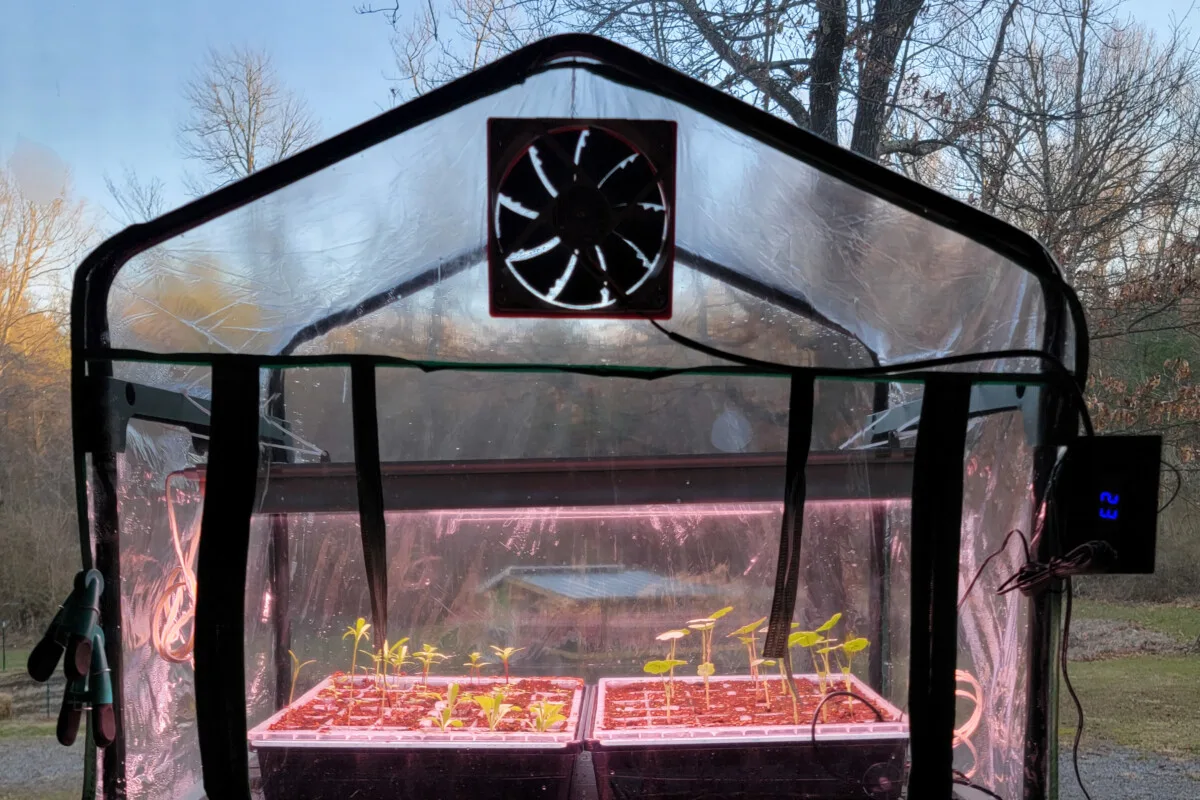
You don’t want anything too powerful that’s going to flatten your little seedlings. The airflow should be enough to stir the leaves gently. For the best results, move the fan to a different position every few days.
Have you ever driven down a country road and noticed how the powerline poles lean in the direction the wind normally blows in that spot?
Yeah, we want to avoid that with our seedlings.
Using a fan means you need to be diligent about watering your seedlings. The airflow will dry out the seed-starting mix much faster, and as the new seedlings have shallow root systems, they can’t go without water for long.
The soil should be slightly damp when you put your fingertip in it. Too much moisture, and you’ll end up with damping-off issues and dead seedlings. If you’re like most gardeners, you’ll be checking on your green babies daily anyway. You’ll notice when they need to be watered.
Feed Your Babies – Fertilizing Tomato Seedlings
Tomatoes are heavy feeders, especially if you want to grow the kind of seedlings that rival anything at your local garden center.
But the most common mistake I see folks make when it comes to seedlings is fertilizing them too soon.
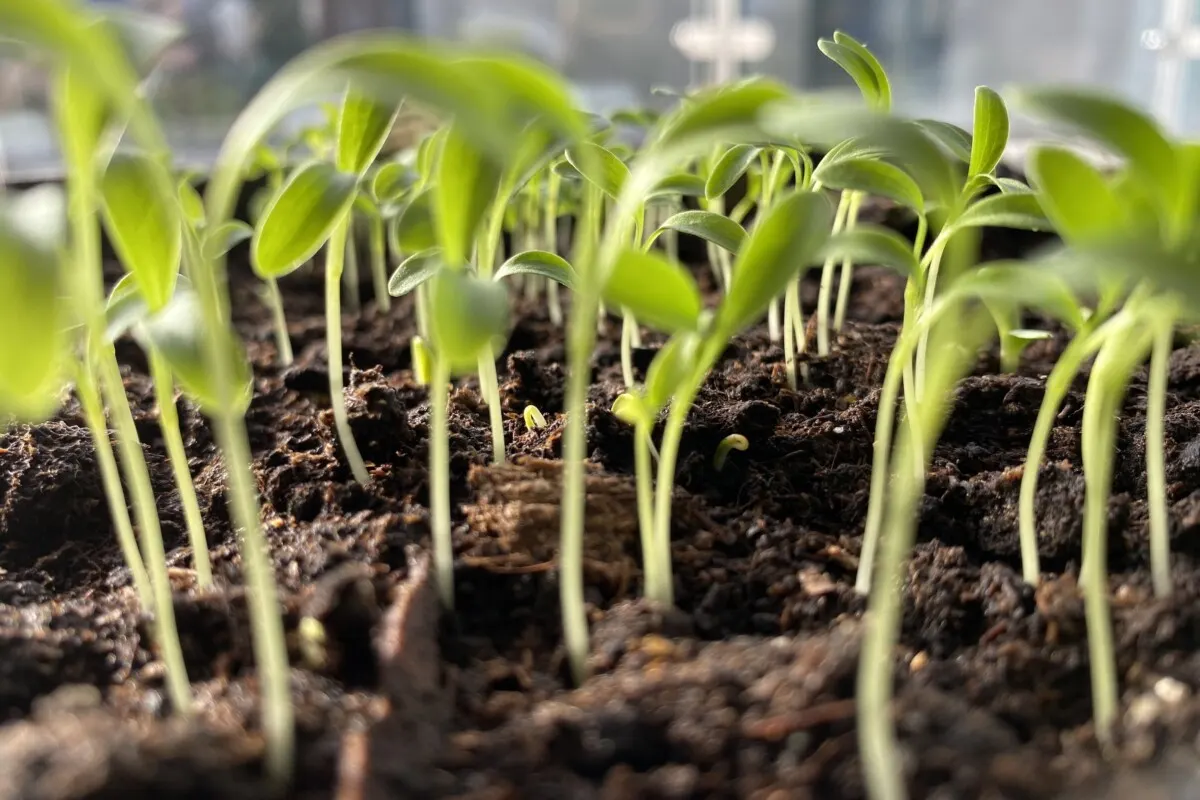
That seed you put in the soil is pretty incredible. Believe it or not, it has everything needed to get a tomato plant off to a good start. The seed contains all the nutrients needed to germinate and begin growing.
Fertilizing too soon can do more harm than good, burning tender new roots.
Don’t fertilize seedlings until they have developed several sets of true leaves. It’s only then that they will actually need it. I start fertilizing once they develop their third set of true leaves.
I never use synthetic fertilizers as it’s much too easy to get the ratios wrong and end up burning new seedlings. (Ask me how I know.) Instead, choose a quality high-nitrogen natural fertilizer and only fertilize at half strength for now.
It’s Better to Fertilize Tomato Seedlings More Often at Half-Strength
It’s important to make sure your seedlings have the nutrients needed to keep up with the rapid growth we’re aiming for. Remember, the seed has everything needed to get them off to a good start. But once they use up those initial nutrients, it’s up to you to provide the rest.
I’ve found it easiest to fertilize more frequently at half-strength. You’re less likely to burn your plants, and you can tell by the growth how they’re doing.
Keep an eye on their color and size.
Dark green leaves mean your tomatoes are receiving adequate amounts of nitrogen and light. If your plants are pale, chances are they need more nitrogen. If they are leaning, they likely need more light. Secondary growth requires extra energy, so thickening stems is also a sign they have all the nutrients they need.
Potting Up Secret – This makes all the difference in my tomato seedlings
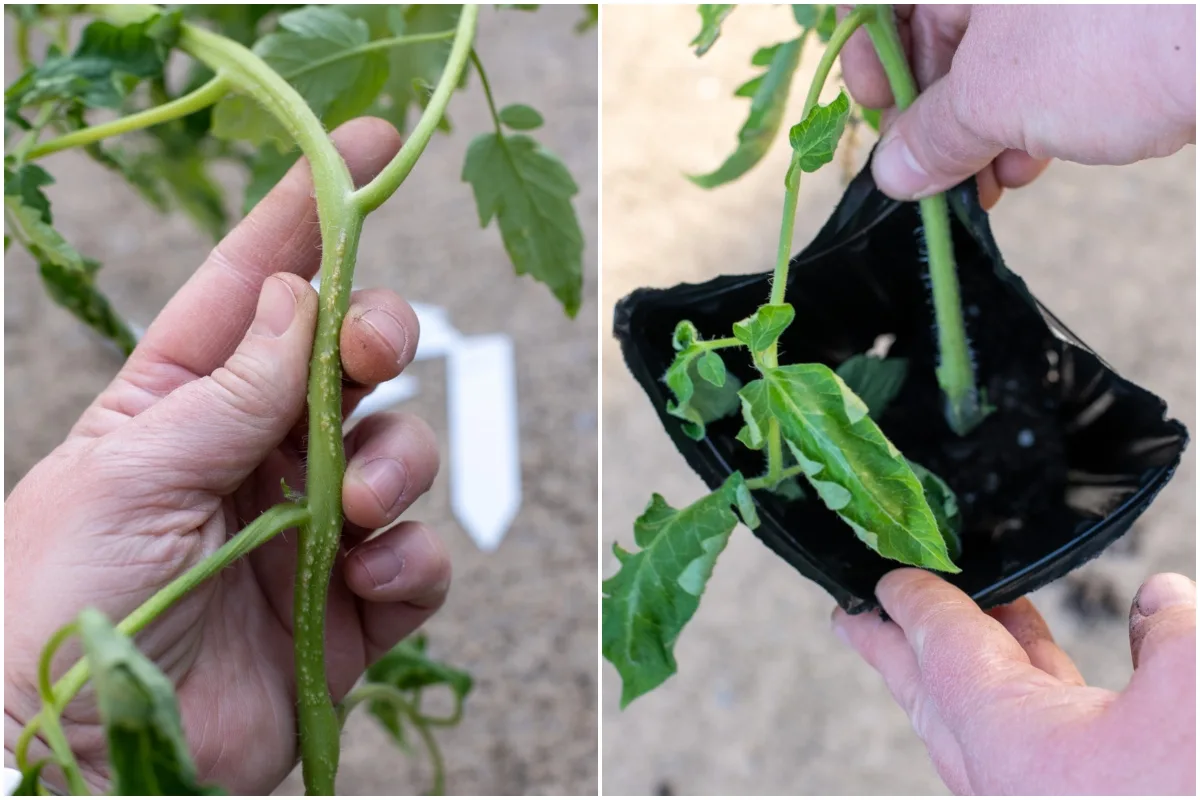
This is probably the best thing I’ve done over the years when it comes to growing big, healthy tomato seedlings. I started potting up my plants differently. It’s important to pot up new seedlings as they grow, but far too often, we focus on what’s going on above the ground.
Tomatoes are pretty cool in that they will grow new roots anywhere along the plant. This is called root primordia.
As any experienced gardener will tell you, it’s all about what’s going on below the soil that counts.
For tomatoes to grow into hefty seedlings with thick stems, they need a root system that can adequately support all that growth. Take advantage of root primordia when potting up by burying part of the stem, and you’ll end up with huge seedlings that grow into massive tomato plants.
To that end, I started potting up my tomatoes using tree-cutting nursery pots. This is the smartest change I’ve made in how I start tomato seedlings.
I use tree-cutting pots (don’t worry, they’re dirt cheap and easy to find) that allow the tomato seedlings to produce a massive root structure before they go into the garden. This is important if you don’t want to waste time waiting for new plants to catch up once they’re planted outside.
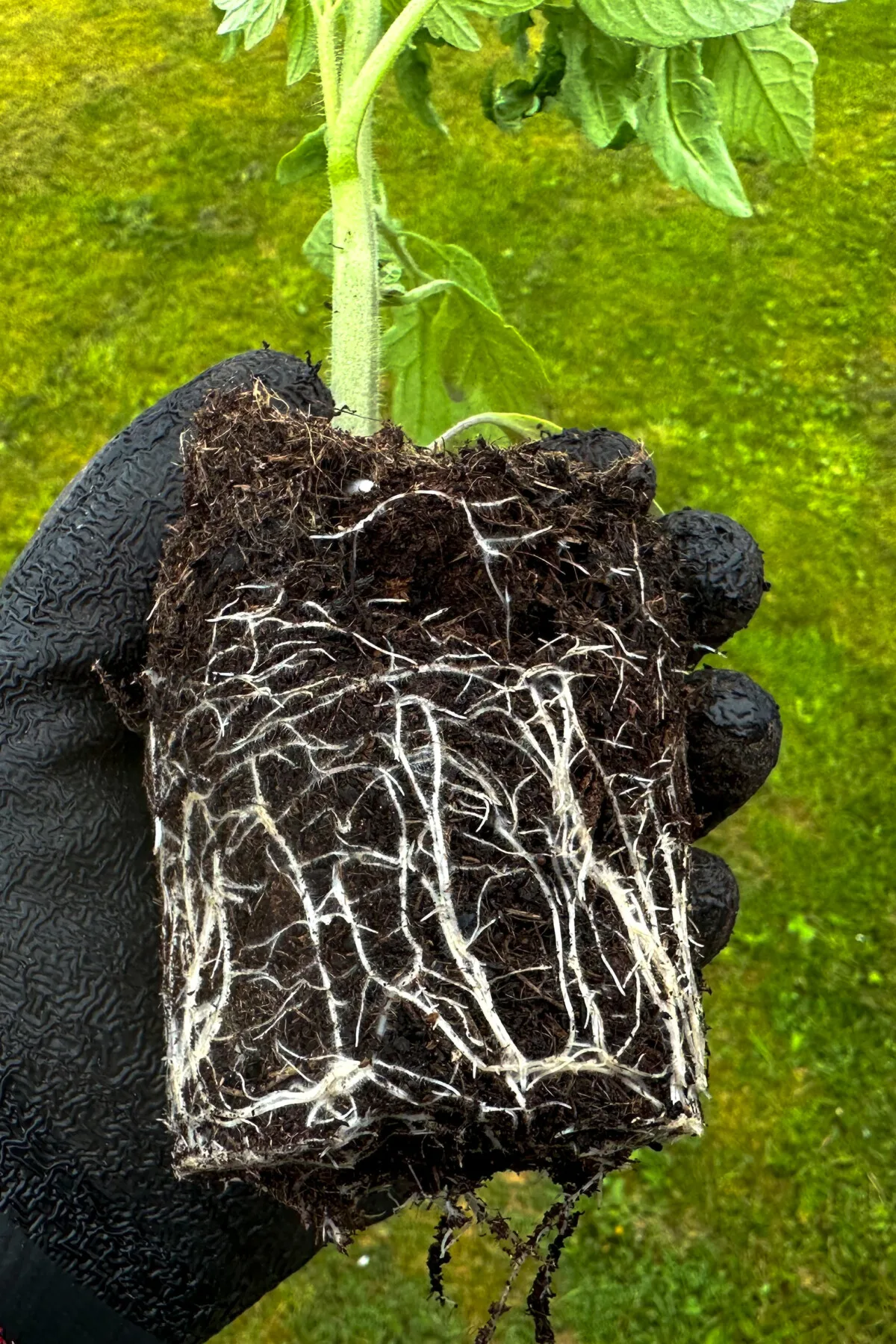
When you pot them up, also inoculate them with mycorrhizae to encourage root growth.
I detail the entire process here: The Potting Up Secret For Growing Monster Tomato Plants
Getting Your Tomatoes Off on the Right Root
Now that you’ve grown some impressive tomato seedlings don’t let all your hard work go to waste. Take care to harden them off and get them in the ground at the right time.
Hardening Off Tomato Seedlings
Far too often, new gardeners (and some older gardeners who should know better) make the mistake of not hardening off their seedlings. You’ve gone to all that trouble of growing and nurturing your seedlings. Make sure you acclimate them to life outdoors before you put them in the ground.
A week or two before you plant your seedlings in the garden, start taking them outside for extended periods. Place them in a sheltered area where they won’t be disturbed if the wind picks up.
Check on them frequently. Outside, those small pots can dry out fast on a warm, breezy day. I almost lost an entire flat of seedlings one year because I forgot to bring them in before I went out to run errands. I came back hours later to wilted seedlings. I was able to nurse some of them back but ended up losing about half.
Don’t be me.
A day or two before you plant them in the garden, the seedlings should be acclimated well enough to stay outdoors the whole time. Again, though, check in on them frequently until you get them in the ground.
Freeze Dates Aren’t Everything – Pay Attention to Soil Temperature
When it comes time to plant your tomatoes outside, we generally adhere to the magical “last expected frost date.” Soil temperature is as important as air temperature. However, we rarely worry about that. If you want a nice, big tomato harvest, it’s time to start paying attention to the soil as well.
Wait to plant your tomatoes outside until the soil is consistently 60 degrees F or above.
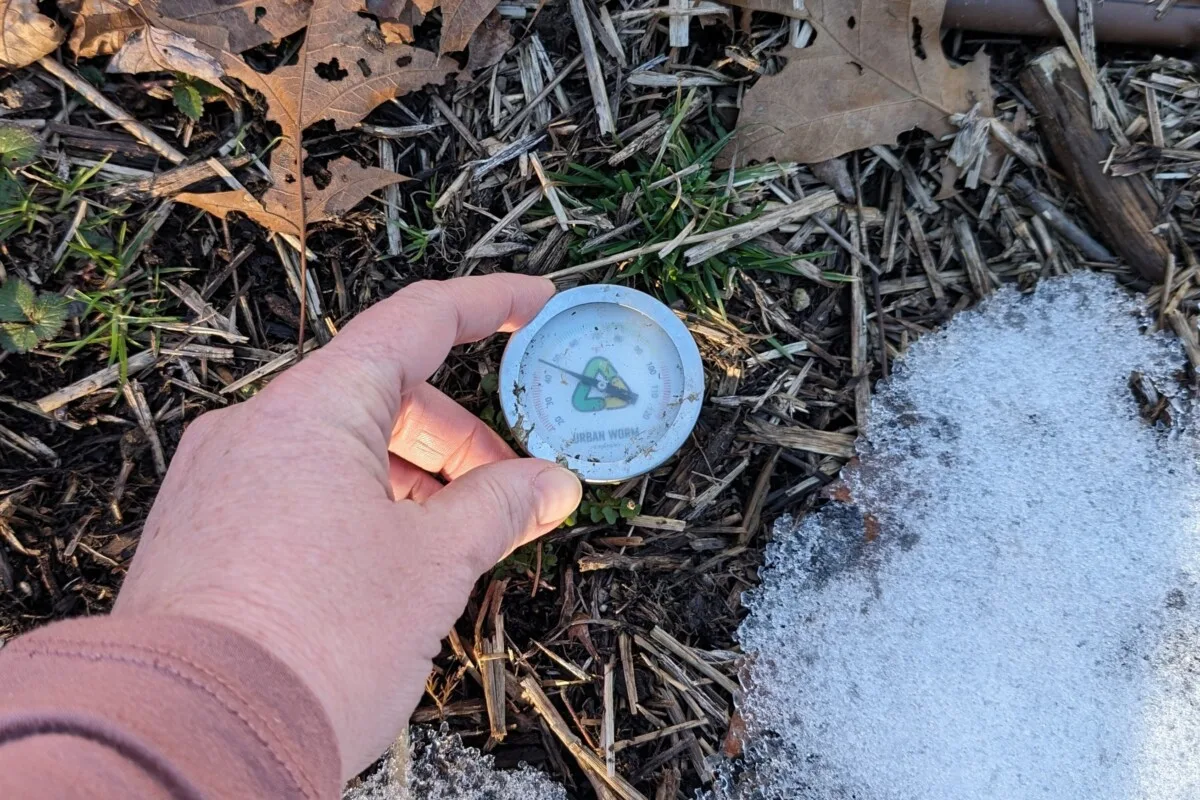
I purchased this silly little soil thermometer a few years ago, and it is easily one of my top five most important gardening tools. I refer to it throughout the growing season.
Planting Your Seedlings – Sideways or Deeply
We’ve already talked about tomatoes’ ability, through parenchyma cells, to put out roots anywhere on the plant and how to take advantage of that by potting up. These thirsty, heavy-feeding plants do best when they’re supported above by a massive root system below.
To further “game the system,” plant them either deeply or on their sides. Either way, it will ensure your tomatoes grow a vast root system below ground. Anywhere the plant is buried, it will put out roots.
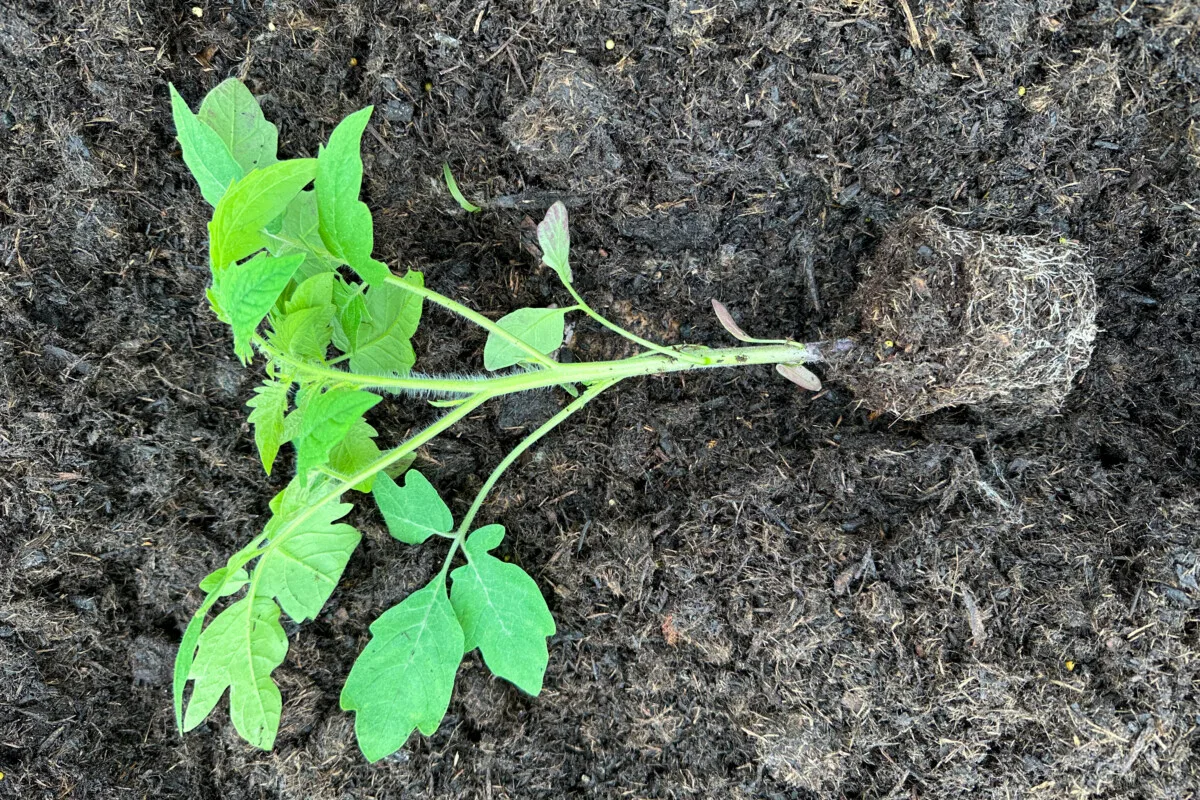
There are some general rules to follow when you plant tomatoes this way, depending on whether they are determinate or indeterminate. You can read up on that information here.
Tomato Seedlings Still Not What You’re Looking For?
At the end of the day, even if you end up with less than Olympian seedlings, they will bounce back once you get them in the garden. But the more of these tips you use prior to the start of the gardening season, the better your chances are of growing exceptional plants. And like any gardener will tell you, there’s always next year. We’re always learning and always trying new methods.

Get the famous Rural Sprout newsletter delivered to your inbox.
Including Sunday musings from our editor, Tracey, as well as “What’s Up Wednesday” our roundup of what’s in season and new article updates and alerts.

